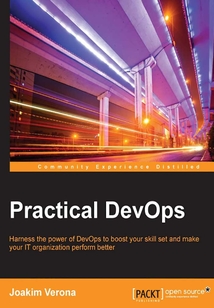舉報 

會員
Practical DevOps
Joakim Verona 著
更新時間:2021-07-16 09:48:32
開會員,本書免費讀 >
最新章節(jié):
Index
Thisbookisaimedatdevelopersandsystemadministratorswhowishtotakeonlargerresponsibilitiesandunderstandhowtheinfrastructurethatbuildstoday'senterprisesworks.Thisbookisalsogreatforoperationspersonnelwhowouldliketobettersupportdevelopers.YoudonotneedtohaveanypreviousknowledgeofDevOps.
最新章節(jié)
- Index
- Summary
- A hands-on lab with an IoT device for DevOps
- Okay but what about DevOps and the IoT again?
- IoT deployment security
- IoT deployment affects software architecture
品牌:中圖公司
上架時間:2021-07-16 09:30:47
出版社:Packt Publishing
本書數(shù)字版權由中圖公司提供,并由其授權上海閱文信息技術有限公司制作發(fā)行
- Index 更新時間:2021-07-16 09:48:32
- Summary
- A hands-on lab with an IoT device for DevOps
- Okay but what about DevOps and the IoT again?
- IoT deployment security
- IoT deployment affects software architecture
- Machine-to-machine communication
- The future of the IoT according to the market
- Introducing the IoT and DevOps
- Chapter 10. The Internet of Things and DevOps
- Summary
- All the trackers
- Problems with issue tracker proliferation
- What do we need from an issue tracker?
- Some examples of workflows and issues
- What are issue trackers used for?
- Chapter 9. Issue Tracking
- Summary
- Log handling
- Graphite
- Ganglia
- Munin
- Nagios
- Chapter 8. Monitoring the Code
- Summary
- Azure
- AWS
- Cloud solutions
- Comparison tables
- Deploying with Docker
- Vagrant
- Salt versus Ansible versus Puppet versus PalletOps execution models
- Deploying with SaltStack
- Deploying with Chef
- PalletOps
- Ansible
- The Puppet master and Puppet agents
- Executing code on the client
- Virtualization stacks
- Why are there so many deployment systems?
- Chapter 7. Deploying the Code
- Summary
- A complete test automation scenario
- REPL-driven development
- Test-driven development
- Testing backend integration points
- JavaScript testing
- Integrating Selenium tests in Jenkins
- Automated GUI testing
- Automated acceptance testing
- Performance testing
- Automated integration testing
- Test Coverage
- Mocking
- JUnit in general and JUnit in particular
- Unit testing
- Pros and cons with test automation
- Manual testing
- Chapter 6. Testing the Code
- Summary
- Robustness
- Taking build errors seriously
- About build status visualization
- Collating quality measures
- Alternative build servers
- Build phases
- Build servers and infrastructure as code
- A look at the Jenkins filesystem layout
- Job chaining and build pipelines
- Triggers
- Software on the host
- Build slaves
- The host server
- Jenkins plugins
- Continuous Delivery
- Continuous Integration
- Cheating with FPM
- The final artifact
- Managing build dependencies
- The Jenkins build server
- The many faces of build systems
- Why do we build code?
- Chapter 5. Building the Code
- Summary
- GitLab
- The pull request model
- Gerrit
- Docker intermission
- Trying out different Git server implementations
- Large binary files
- Hosted Git servers
- Shared authentication
- Setting up a basic Git server
- Choosing a client
- Artifact version naming
- Branching problem areas
- Choosing a branching strategy
- A word about source code management system migrations
- Which source code management system?
- Roles and code
- The history of source code management
- The need for source code control
- Chapter 4. Everything is Code
- Summary
- DevOps architecture and resilience
- Microservices and the data tier
- How to keep service interfaces forward compatible
- Interlude – Conway's Law
- Microservices
- Manual installation
- The pom.xml file
- The changelog file
- Hello world in Liquibase
- Rolling upgrades
- Handling database migrations
- The data tier
- The logic tier
- The presentation tier
- Three-tier systems
- A practical example
- Back to the monolithic scenario
- Coupling
- The principle of cohesion
- The separation of concerns
- Architecture rules of thumb
- The monolithic scenario
- Introducing software architecture
- Chapter 3. How DevOps Affects Architecture
- Summary
- Identifying bottlenecks
- Wrapping up – a complete example
- Scrum Kanban and the delivery pipeline
- Release management
- The DevOps process and Continuous Delivery – an overview
- Chapter 2. A View from Orbit
- Summary
- DevOps and ITIL
- Beware the cargo cult Agile fallacy
- The Agile wheel of wheels
- How fast is fast?
- Introducing DevOps
- Chapter 1. Introduction to DevOps and Continuous Delivery
- Customer support
- Reader feedback
- Conventions
- Who this book is for
- What you need for this book
- What this book covers
- Preface
- Support files eBooks discount offers and more
- www.PacktPub.com
- About the Reviewers
- About the Author
- Credits
- 版權頁
- 封面
- 封面
- 版權頁
- Credits
- About the Author
- About the Reviewers
- www.PacktPub.com
- Support files eBooks discount offers and more
- Preface
- What this book covers
- What you need for this book
- Who this book is for
- Conventions
- Reader feedback
- Customer support
- Chapter 1. Introduction to DevOps and Continuous Delivery
- Introducing DevOps
- How fast is fast?
- The Agile wheel of wheels
- Beware the cargo cult Agile fallacy
- DevOps and ITIL
- Summary
- Chapter 2. A View from Orbit
- The DevOps process and Continuous Delivery – an overview
- Release management
- Scrum Kanban and the delivery pipeline
- Wrapping up – a complete example
- Identifying bottlenecks
- Summary
- Chapter 3. How DevOps Affects Architecture
- Introducing software architecture
- The monolithic scenario
- Architecture rules of thumb
- The separation of concerns
- The principle of cohesion
- Coupling
- Back to the monolithic scenario
- A practical example
- Three-tier systems
- The presentation tier
- The logic tier
- The data tier
- Handling database migrations
- Rolling upgrades
- Hello world in Liquibase
- The changelog file
- The pom.xml file
- Manual installation
- Microservices
- Interlude – Conway's Law
- How to keep service interfaces forward compatible
- Microservices and the data tier
- DevOps architecture and resilience
- Summary
- Chapter 4. Everything is Code
- The need for source code control
- The history of source code management
- Roles and code
- Which source code management system?
- A word about source code management system migrations
- Choosing a branching strategy
- Branching problem areas
- Artifact version naming
- Choosing a client
- Setting up a basic Git server
- Shared authentication
- Hosted Git servers
- Large binary files
- Trying out different Git server implementations
- Docker intermission
- Gerrit
- The pull request model
- GitLab
- Summary
- Chapter 5. Building the Code
- Why do we build code?
- The many faces of build systems
- The Jenkins build server
- Managing build dependencies
- The final artifact
- Cheating with FPM
- Continuous Integration
- Continuous Delivery
- Jenkins plugins
- The host server
- Build slaves
- Software on the host
- Triggers
- Job chaining and build pipelines
- A look at the Jenkins filesystem layout
- Build servers and infrastructure as code
- Build phases
- Alternative build servers
- Collating quality measures
- About build status visualization
- Taking build errors seriously
- Robustness
- Summary
- Chapter 6. Testing the Code
- Manual testing
- Pros and cons with test automation
- Unit testing
- JUnit in general and JUnit in particular
- Mocking
- Test Coverage
- Automated integration testing
- Performance testing
- Automated acceptance testing
- Automated GUI testing
- Integrating Selenium tests in Jenkins
- JavaScript testing
- Testing backend integration points
- Test-driven development
- REPL-driven development
- A complete test automation scenario
- Summary
- Chapter 7. Deploying the Code
- Why are there so many deployment systems?
- Virtualization stacks
- Executing code on the client
- The Puppet master and Puppet agents
- Ansible
- PalletOps
- Deploying with Chef
- Deploying with SaltStack
- Salt versus Ansible versus Puppet versus PalletOps execution models
- Vagrant
- Deploying with Docker
- Comparison tables
- Cloud solutions
- AWS
- Azure
- Summary
- Chapter 8. Monitoring the Code
- Nagios
- Munin
- Ganglia
- Graphite
- Log handling
- Summary
- Chapter 9. Issue Tracking
- What are issue trackers used for?
- Some examples of workflows and issues
- What do we need from an issue tracker?
- Problems with issue tracker proliferation
- All the trackers
- Summary
- Chapter 10. The Internet of Things and DevOps
- Introducing the IoT and DevOps
- The future of the IoT according to the market
- Machine-to-machine communication
- IoT deployment affects software architecture
- IoT deployment security
- Okay but what about DevOps and the IoT again?
- A hands-on lab with an IoT device for DevOps
- Summary
- Index 更新時間:2021-07-16 09:48:32


